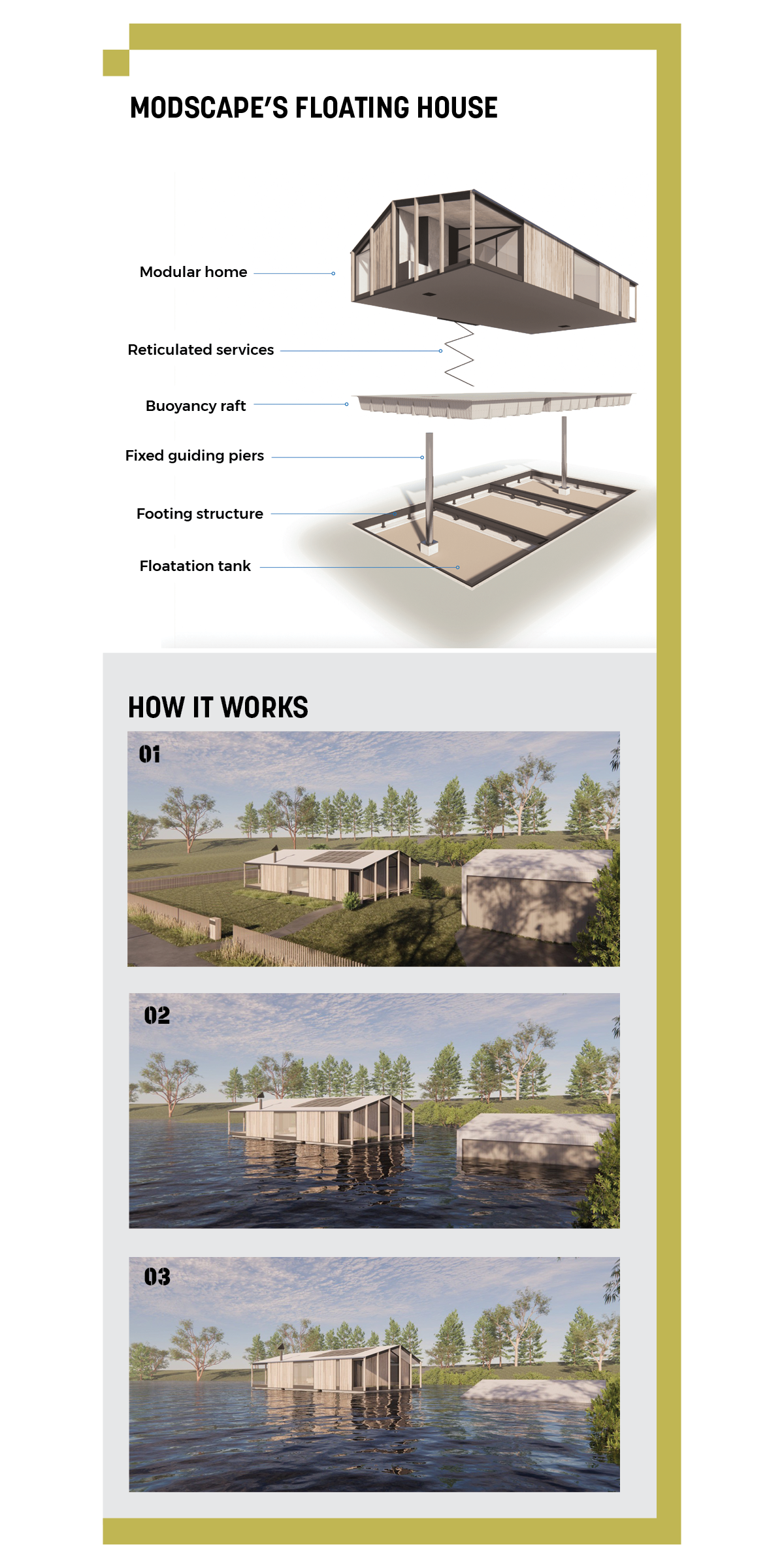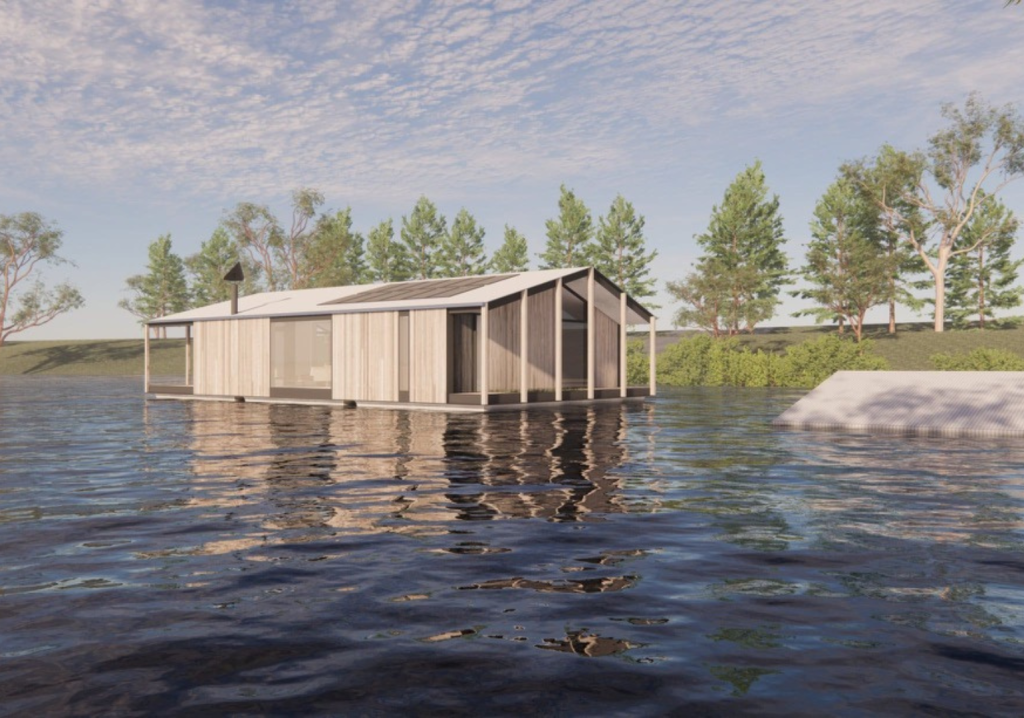Flooding along Australia’s east coast in 2022 was one of the costliest disasters in the nation’s history. This has led to calls for land use planning to prevent development in high-risk zones and recognition of flood-resilient design in construction codes.
Record-breaking rainfall and floods affected towns and cities from Queensland to Tasmania, with some experiencing up to five times their average monthly rainfall according to the Bureau of Meteorology. Some homes and businesses were inundated four times in 18 months.
Australian modular design and construction company Modscape had already been thinking about a house able to adapt to changing water levels. The events of 2022 propelled them to put “pen to paper”, according to New Business Director Josh Chaplin.

Using the company’s speciality, the Floating House concept is designed to rise above floodwaters and return to its foundations as waters recede, remaining safe and fit for reuse.
Modscape’s house “floats” when floodwaters rise thanks to an underlying buoyancy raft. Guiding piers provide stability, while allowing for vertical movement.
“An innovative ‘zig-zag’ connection system – based on practical applications seen in cement trucks – enables essential services to be compact during normal conditions, then extending as the building rises,” Chaplin said.

Overseas examples
The approach draws inspiration from projects successfully implemented abroad.
Dr Elizabeth English has been working on floating homes for nearly two decades. In 2005, English was working as an associate professor at Louisiana State University’s Hurricane Center, just as Hurricane Katrina – the most destructive and one of the deadliest hurricanes in US history – made landfall over Florida, Louisiana and Mississippi.
At the time, English – who holds qualifications in both architecture and civil engineering – had been researching wind effects on buildings for more than 25 years.
Yet she observed much of the damage wrought by Katrina wasn’t solely caused by strong winds. Levees designed to protect the city collapsed, leaving at least 80 per cent of New Orleans under floodwater.
She realised: “Wind is bad. But flooding, when it happens, is worse.”
In the wake of Katrina, English shifted her primary research focus from wind to water, founding the Buoyant Foundation Project to develop an innovative system for housing in flood-prone areas.
Elevation – staying high and dry – is a primary strategy for reducing flood risk. But permanently elevating a house is expensive, she said, making it a solution that’s out of reach for many marginalised communities.
Retrofitting existing buildings
As a more affordable alternative, the Buoyant Foundation Project developed an “amphibious” retrofit system.
“It’s really like installing a floating dock under your house,” English said.
The system works by fitting a frame between the floor and foundations of an existing house. Then, buoyancy elements – manufactured dock floats or blocks of expanded polystyrene – are installed underneath. The frame transfers gravity loads to the uplift from buoyancy blocks when water rises. A set of vertical guidance posts restricts movement, preventing the house from moving sideways.
The approach is best suited for existing houses that are already slightly elevated – on short piers or with a crawl space underneath – a standard type of construction in Louisiana. It’s mostly designed to protect against rising waters (at a velocity of no more than two metres per second) rather than a raging stream.
While occupants would still evacuate with their neighbours during flood events, buoyant designs avoid the trauma of returning to a home and possessions ruined by mud, debris and water.
The initiative has built full-scale prototypes in North America and has successfully retrofitted several houses in the Mekong Delta in Vietnam.
English said when she first started working on these ideas, for several years “I couldn’t talk about it without being laughed at”.
But as major floods wreak havoc around the globe concepts such as flood-resilient design, even amphibious or floating architecture, have started to seep in.
Infrastructure damage
Evelyn Storey FIEAust CPEng is Chair of the Structural College at Engineers Australia and the Managing Director, Queensland, for engineering consultancy Aurecon.
For many in the Sunshine State, the 2011 floods – when 75 per cent of Queensland was declared a disaster zone – were a crucial turning point.
In that event, prolonged rainfall on already saturated catchments led to “flooding of historic proportions”, according to the Queensland Floods Commission of Inquiry. More than 30 people lost their lives, critical infrastructure was damaged and thousands of homes had to be rebuilt.
Debris washing down the Brisbane River smashed into pedestrian bridges and ferry terminals, wiping out critical public and active transport infrastructure.
When the ferry terminals were replaced, the new designs were engineered to withstand a one-in-500 year flood event, Storey said. Massive piers included deflectors to divert heavy objects; floating gangways were designed to disengage in rising floodwaters and swing behind the pontoon.
Engineers are used to designing for seismic and wind events – even snow – Storey said, although that’s generally not something Queenslanders worry much about. For those risks, the National Construction Code sets out importance levels and return periods for different types of buildings. Flooding doesn’t appear in the same way.
“Heavy rainfall and flooding introduce a whole new set of risks,” Storey said.
A slow, steady rise of water might not create additional loads, but can cause extensive water damage. While a riverine or storm surge of water and debris carries destructive force.
“Designing for those risks can feel a bit like unchartered waters,” she said.
Resilient engineering
Clarity in building codes and guidelines can help. In February, the Queensland government published new flood-resilient design guidelines, to help housing withstand multiple significant inundations and allow occupants to more easily clean, repair and return to their homes with minimal cost and disruption.
The guidelines detail measures such as elevation, wet-proofing (hard surfaces such as tiling and concrete for easier cleaning, utilities installed above the flood line) and landscaping to slow or redirect floodwaters.
Both Chaplin and English see flood-resilient designs as a way to maintain people’s connection to their local communities and culture. Chaplin says a key driver for Modscape’s initiative was the plight of Indigenous communities in flood-affected areas who carry deep-rooted connections to their ancestral land.
But flood-resilient housing faces other hurdles beyond technical design.
“I thought that the challenge would be the engineering, figuring out how to do it,” English said. “Actually, the policy issues are much stickier.”
Other aspects such as insurance practices, planning and building codes can pose major barriers and delays to implementation.
Modscape has yet to construct its Floating House, with challenges remaining around regulatory compliance and insurance.
Considerate regulation
Dr Sandeeka Mannakkara trained as a structural engineer and is currently a senior lecturer in climate engineering at the University of Auckland.
New Zealand is still recovering from its own unprecedented flooding and cyclone events in 2023.
Mannakkara said rebuilding and recovery efforts offer a unique opportunity to “build back better”, planning and designing resilience for a range of climate change scenarios.
But she agreed engineering is only part of that picture.
“There are lots of crucial ingredients; it’s not straightforward at all,” she said.
To illustrate, she used the case study of the Victorian government’s response to the 2009 Black Saturday bushfires.
“They did many things right,” she said, including risk-based land use planning, updated building codes, new fire-resistant materials and a voluntary buyout scheme.
Yet reconstruction efforts were hampered by insurance, which covered the original cost of the house, but not the additional cost of more resilient builds under strengthened regulations. This stalled reconstruction efforts, leaving people even more vulnerable.
Mannakkara explained this is why getting climate resilience right might require engineers to “look beyond their calculations” – and collaborate with planners, local residents, Indigenous communities, businesses and even insurers when coming up with solutions.
Storey added that implementing climate-responsive designs may require engineers to step into the arena of policy advocacy.
“We need to be out there in front, because we have solutions, we have recommendations – but it’s not cutting through.”
